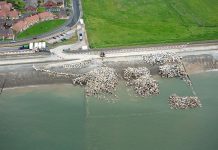Dr Anne Kemp, Chair, BIM4IUK enthuses about the potential of blending the BIM vision with that of geographic principles and how it could be utilised to deliver major infrastructure projects
I believe that the convergence of BIM and geospatial in delivering major infrastructure projects is a game changer. But it will only be so if we understand and adopt a more holistic approach. And we can only do this if we consider the wider philosophy and approach of BIM and geospatial, rather than simply their tools and technologies.
The UK Government BIM programme is driven by the principle of managing information across the whole life of an infrastructure project, starting with the end in mind, and continuing forward to managing information across the whole infrastructure portfolio – with projects serving the needs of the wider context. That context may be a single organisation, such as Thames Water, Crossrail, Highways Agency, National Grid or Vodafone – but the real prize is if this can work across the whole of the UK’s infrastructure.
I am a geographer, just finishing two years as chair of the Association of Geographic Information. Consider the brand straplines of AGI – “championing the value that the intersection of geography and information has for the economy, business and for the individual”, and of the Royal Geographic Society (RGS) – “…the place for all those who want to know more about our planet and its people”. I have been working in the AEC industry for 25 years, and serve as the Chair of the Institution of Civil Engineers’ BIM Action Group, and of BIM4Infrastructure UK.
Throughout my career I have been striving to make the right and relevant information available to the right people at the right time to stimulate thought and to facilitate better decision making. What fascinates and excites me about the potential in blending the BIM vision with that of geographic principles is the convergence of how we design and manage our physical infrastructure – both man-made and natural – with the human dimension. We can do this if we achieve collaboration across professions – but we need to cross the boundaries which exist between disciplines and between industries.
I reflect that what gives us so much angst is what we believe or interpret to be “right”, and it is here that perhaps we make the most mistakes. For each of us, our behaviours and our outlook are governed, often unconsciously by our background – our culture, our education, our discipline, our profession. And this can lead us, intentionally or not, to reject valuable and relevant approaches, data and information from sources which we are not familiar with, or we don’t trust. Time and again I have seen barriers to sharing valid and insightful data or ideas arise through differences in professional language and approach.
Both geospatial and BIM technologies are there to serve data from disparate sources into a common pool in such a way that it can be trusted and understood by people from a range of backgrounds, disciplines and skills. The art and science of cartography has evolved to portray the real world in 2 dimensions, in a way which enhances and clarifies understanding. There are good and bad examples of where this discipline has been carried into GIS. There are many lessons to be learned about the dangers which can occur if information is inaccurate, incorrect, distorted, manipulated or mis-represented. And where an individual’s privacy can be invaded by inappropriate integration and sharing of pertinent datasets. We must carry these lessons forward as we extend our use of digital technologies to convey our understanding and interface with the world around us.
Every physical thing has a place and a given state and context in time. Our moods can be tracked through time and space – and the way we are impacted by, and adapt, to the world around us. As we move forward, and integrate the internet of things and of people with the physical infrastructure which we plan, design, construct and maintain, so will we enhance our understanding, and our ability to monitor, guide and control our behaviours and interaction with the man-made and natural environments which make up our planet. As planners, the socio-economic dimension has always played a part in the consideration of projects. But as we see a convergence of our physical world with the virtual world delivered through our mobile devices, so I anticipate the psychological dimension requiring more and more attention (see Susan Greenfield’s “Mind Change”, 2014, for more information). Furthermore, the amount of information which our senses receive, whether within the work environment, or within our day to day living, has been increasing rapidly. But information is not understanding, and we need to ensure that each of us is empowered and equipped to challenge the information which is served to us.
We need to ensure that BIM and GIS provide us with the information and the tools to enable us to interrogate, question and challenge the scenarios presented to us – and to allow us to make wise decisions which build on and complement the intellectual and analytical power which artificial intelligence will increasingly present to us.
So this is where I believe the convergence of BIM and geospatial can take us over the next decade in improving how we manage and interface with the outcomes of our major infrastructure projects. And while much has changed, we have a long way to go. There are arguments that the vision of the internet of things has not been realised because of the lack of standards. But there are more fundamental things missing before we are ready for that progression. In the UK, our ability to record and maintain a comprehensive dataset of our buried infrastructure is hindered – not by technology – but by lack of policy and process. If as a country we really want to realise the vision of Digital Built Britain, then we must as an industry pull together and make this happen.
Without doubt, there are problems around security. Without doubt there are challenges with standards. And without doubt there are issues around education and training. But what we really need is agreement – an understanding, and galvinisation around a common framework which can allow us to take this next important step, integrating both geospatial and BIM practices toward a coordinated, comprehensive and integrated model of our underground world equivalent to that above the surface. A number of activities are underway to seek to achieve this.
Do get in touch if you would like to find out more.
ICE is working in a number of areas to enable this, and would be keen to know of others who have an interest in this area. If you are, please contact Richard Armstrong on 0207 665 2411 richard.armstrong@ice.org.uk Information Systems Panel, Geospatial Engineering Panel and BIM Action Group secretariat.
Dr Anne Kemp
Director (BIM Strategy and Development) at Atkins, Chair for BIM4Infrastructure UK and ICE
BIM Action Group and Vice Chair for BuildingSmart UK
bim4iuk@gmail.com
www.ice.org.uk/topics/BIM/ICE-BIM-Action-Group
www.bimtaskgroup.org/bim-4-infrastructure-uk/









